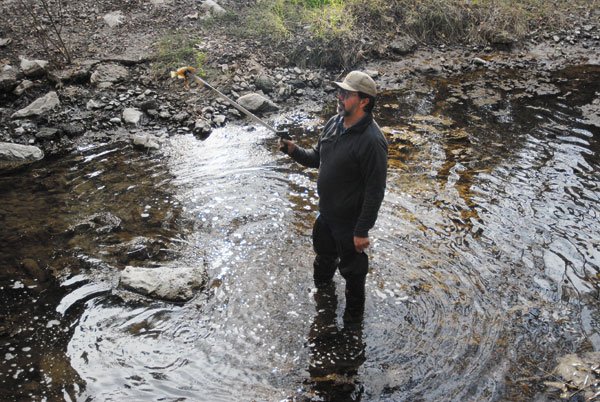Before Keith Anderson saw any of the hundreds of dead fish
floating in Uvas Creek, the stench of rotten eggs told him to
expect the worst.
Gilroy – Before Keith Anderson saw any of the hundreds of dead fish floating in Uvas Creek, the stench of rotten eggs told him to expect the worst.
The sewage-like stink was hydrogen sulfide, a gas produced when bacteria break down organic matter, and it does not bode well for aquatic life, explained Anderson, a retired senior fishery biologist with the California Department of Fish and Game.
“(The fish) had no chance with the lack of oxygen and this hydrogen sulfide,” Anderson said. “Not only was it killing the fish, it was killing off the crayfish, the long filament-like algae and other nonfish organisms.”
Anderson was among a dozen environmental stewards, state game wardens and water district officials who crept along the banks of Uvas Creek this weekend, following a trail of more than 1,000 dead fish to a culvert running from Christopher Ranch. The famed south Gilroy garlic producer is the lead suspect in a state investigation of a wastewater spill, but Anderson also lays blame on “poor management” at the Santa Clara Valley Water District.
As part of an experiment to improve spawning conditions for endangered Steelhead trout, the agency depleted Uvas Reservoir this summer more than it has in past years. The well-intentioned gamble, when combined with an unusually dry winter and a wastewater spill south of Gilroy, created ripe conditions for an environmental disaster, Anderson said.
“The water district sort of bet it would be a normal (rain season) … and the regulatory agencies probably thought the district knew what it was doing,” he said. “It’s an example of good intentions gone wrong.”
The water district’s experiment involved releasing higher levels of water during the summer months from Uvas Reservoir, roughly 10 miles north of Gilroy, to prevent creeks from drying out south of the city.
Normally, creek levels must be highest in winter when steelhead arrive to spawn. Every March and April, steelhead that have spent a few seasons growing upstream transform into ocean fish – a process known as smolting – and make their way down to the Pajaro River and out into Monterey Bay. In a typical year, the path to the ocean is cut off in summer, when Uvas Creek dries out south of Christmas Hill Park.
“By releasing more water this summer, we were trying to determine if that would produce a larger crop of steelhead,” said Scott Akin, an environmental engineer with the water district. “We’ve had several years in a row of above average rainfall and so we had what we thought were really good conditions to try this experiment.”
The project was conducted in collaboration with the National Marine Fisheries Service, which enlisted local environmental stewards to monitor creeks as water levels dropped. Volunteers with Coastal Habitat Education and Environmental Restoration, a Gilroy nonprofit, discovered the wastewater spill Saturday morning during a routine check-up at the crossing of Bloomfield and Old Bolsa roads.
“The water was all black and it smelled like a sewer,” said Herman Garcia, a cofounder and president of CHEER. “It killed everything in it’s path.”
Initial searches turned up only about 10 dead steelhead, but Garcia and his fellow volunteers discovered at least five dead baby steelhead Tuesday. He believes far more than 15 died, but he said a true count may never be known because many of the smaller fish have already sank beneath the water, hidden among blackened algae and muddy water.
Despite the fallout of the Uvas Creek spill, Akin said the experiment helped increase the steelhead population.
Anderson, who serves on a group of biologists and other science advisors to the district, said the success came at a high cost – upsetting the region’s delicate ecological balance.
Inject a dose of organic byproducts into the equation, and the fish didn’t stand a chance, he added.
“There’s an assumption now that it’s a garlic residue,” Anderson said, explaining that “as this organic matter settles out on the bottom (of the stream), bacteria are decomposing it and robbing the water of oxygen, so the fish are dying of suffocation.”
The hydrogen sulfide – also highly lethal to fish – is produced by a second set of bacteria eating away at plants.
“It just added insult to injury,” Anderson said.
Now, he and other environmental experts are hoping that rain will help avoid additional damage by diluting and clearing out the pollutants.
“We’ve got our fingers crossed for some good storms,” Akin said.
Weak storms, however, could actually worsen the problem, said Captain Doug Huckins of the California Department of Fish and Game.
“The only trouble with rain is that if it increases the volume of the creek significantly, it may take the pollutant and just disperse it downstream, where it could settle again,” he said.
The agency will decide in the next day or two if it should proceed with a clean-up or take a chance on the weather. In the meantime, game wardens are completing their investigation of Christopher Ranch.
The wastewater, laced with what are thought to be pieces of processed garlic, were released accidentally into storm drains on Christopher Ranch, Huckins said. Those storm drains flow into a culvert that empties into Uvas Creek.
Game wardens will hand over their findings to district attorneys, who will decide whether or not to file criminal charges or a civil lawsuit.














